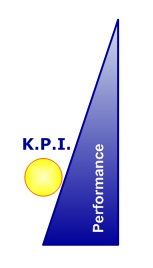KEY PERFORMANCE INDICATORS
Key Performance Indicators (KPIs) are a set of quantifiable measurements that highlight the critical success factors of an organization. They are used to gauge or compare performance in terms of meeting the organization’s strategic goals and objectives. KPIs focus on the most important performance information that enables organizations to understand whether they are on track to meeting their goals.
Key Performance Indicators (KPIs) – set of quantifiable measurements that highlight the critical success factors of an organization.
These indicators are similar to what a doctor does during a physical check-up. He or she might measure key indicators of a person’s health such as blood pressure, heart rate, respiratory rate, cholesterol levels, and body temperature. KPIs are similar type of vital signs for an organization.
One of the main purposes of KPIs is to reduce the complex nature of organizational performance to a few key factors in order to make the overall performance more understandable and manageable. These assessments often lead to the identification of problems as well as areas for potential improvements. Also like physical health, if a doctor notices a potential issue, he or she may monitor it or take action to address the current results (i.e. prescribe medication).
Setting Key Performance Indicators
The first steps in measuring performance are to analyze the company’s mission and then set strategic goals to align with that mission. After the strategic goals are defined, an organization needs a way to measure progress toward those goals, and this is done through the organization’s determination of their KPIs. Each organization will have their own specific indicators based on what is import to them. However, whatever Key Performance Indicators are selected they must:
- be linked to the organization’s goals
- be key to its success
- be objectively defined
- be quantifiable/measurable
KPIs should clearly be linked to the strategic goals and objectives of the organization to help monitor the execution of the business strategy. The goals for a particular KPI may change as the organization’s goals change.
Key Performance Indicators must also be objectively defined in order to provide a quantifiable and measurable indication of the organizations progress towards achieving its goals.
Measuring What Matters the Most
As Peter Drucker said, “What gets measured, gets managed.” Therefore, it is essential to make sure what is being measured is what is really important to the company’s success. What is important often depends on who is measuring it. KPIs differ depending on the organization.
- A business may focus on net revenue or the percentage of its income that comes from return customers.
- A school may focus on graduation rates of its students or how their students compare to the national average in test scores.
- A government agency might consider unemployment rates or consumer confidence.
- A social service organization might focus on the number of individuals they provided assistance for during specific months or from whom/where they get their donations.
Not only do Key Performance Indicators differ per organization they also often differ from department to department within an organization. The KPIs useful for one department or division of a company may not be useful at all for another. For example, a Sales Division would have different indicators than the Production or Finance Divisions. Additionally, a Customer Service Department may measure percentage of customer calls answered in the first minute.
Conclusion
It is import to identify Key Performance Indicators, it is also important they are:
- linked to the organization’s goals
- reflect what is most important to the organizations success
- objectively defined
- quantifiable/measurable
- reviewed and analyzed
- periodically reviewed against current strategic goals
- utilized to improve performance




